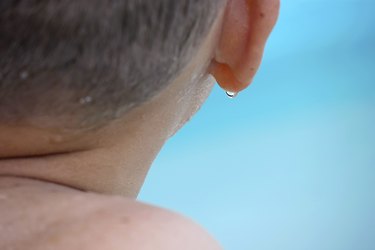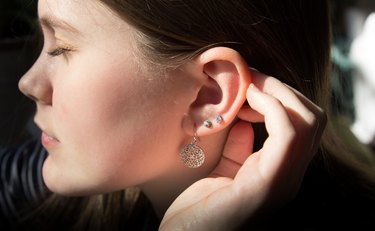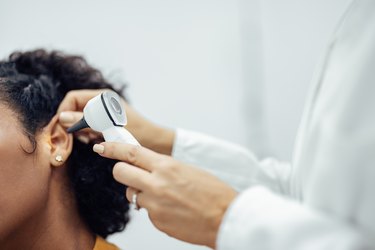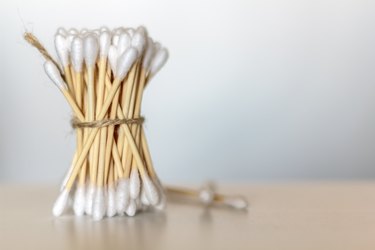
Getting water in your outer ear canal may be irritating, but it's rarely serious.
Symptoms are similar to having wax in your ear — muffled hearing (although your own voice sounds louder) and a feeling that your ear is stopped up — but you'll know it's water because you've just been swimming, bathing, showering or even sweating profusely, says William R. Blythe, MD, an otolaryngologist in private practice in Opelika, Alabama.
Video of the Day
Video of the Day
The trick is to get it out quickly. If water is stuck in your ear for days, it could lead to an infection called swimmer's ear (otitis externa). Here's how to drain your ears at home quickly.
1. Shake Your Head
The majority of folks can get water out of their ear just by shaking their head after they get out of the pool, tub or shower.
"For the most part it's easily dislodgeable," says Rupali Shah, MD, associate professor in the department of otolaryngology at the University of North Carolina School of Medicine. "Tilt your ear over, sometimes jiggle your ear or pat it. It's almost like you need to break the tension just to get it to fall out."
2. Enlist Gravity and Time
Tilt your head to the side so your ear faces down toward the ground.
"Gravity is your best friend," Dr. Blythe says. "Turn to the side and give it a little bit of time. A lot of times, particularly if the water is cool, when it gets to body temperature, it will just drain out."
You can also pull your ear away from your head (gently) to move things along. "This straightens the ear canal and may help water drain out," Dr. Blythe says. Sometimes massaging your outer ear can help drain the canal, too, he adds.
Related Reading
3. Wipe Your Ear With Your Finger and a Washcloth or Tissue
But never with a Q-tip or other implement like a bobby pin or paper clip.
"It's perfectly fine to put your finger or washcloth or a tissue down as far as your finger will go," says Dr. Blythe. "[That way], you cannot get very deep into the canal and you won't hurt anything."
Putting anything else in there runs the risk of severely damaging your ear.
4. Use a Solution of Alcohol and Vinegar
According to the University of Iowa Hospitals & Clinics, applying a solution that's equal parts rubbing alcohol and white vinegar can get rid of the water. The alcohol dries while the vinegar, which is similar in acidity to the ear, prevents your ear form getting infected, explains Dr. Blythe.
A medicine dropper is the easiest way to apply a couple of drops, he adds.
Over-the-counter ear drops from your local pharmacy are typically a similar mixture of alcohol and vinegar, says Dr. Blythe.
Warning
Don’t use this method if there’s any chance you have a hole in your eardrum, say from an impact like falling while water skiing, or if you have a history of ear trouble. The solution will burn your ear, Dr. Blythe says.
5. Try a Solution of Vinegar and Water
Kristen Angster, MD, a specialist in the department of otolaryngology–head and neck surgery at Henry Ford Health System in Detroit, recommends a solution of equal parts white vinegar and water (ideally distilled water). "The vinegar is the right pH [acidity] for the ear canal, so it will help dry it without overly drying, which alcohol can do," she explains.
The trick is that the solution has to be body temperature, otherwise it'll make you dizzy. "Ideally, you want to sit down in a bathtub so you don't fall if you do get dizzy," says Dr. Angster. "Mix it in a cup and draw it out with an infant medicine syringe from a drug store. Test the mixture on your wrist, then tilt your ear down towards the ground and gently shoot it up into the ear."
Be sure the syringe tip isn't too long so it doesn't hurt your ear.
What About Q-tips?
No, no, no to Q -tips or cotton swabs in your ear. The same goes for anything else "smaller than your elbow" inserted into your ear, Dr. Shah says. These could severely damage your ear.
"Some people have really short ear canals, which means the eardrums are much closer to the surface than you realize," says Dr. Angster. "And when you put any foreign body in your ear, it packs the wax down deeper and makes it harder to remove."
What About Peroxide?
Hydrogen peroxide or peroxide-based drops are typically used to remove earwax when it's blocking the ear canal, says Dr. Blythe. It's not recommended for water, and it can change the pH level of the ear, setting the stage for infections.
Even to remove wax, Dr. Angster dissuades patients from putting it in their ear at home. "If it gets caught in the wax, it can get pretty irritating," she says. "You can dissolve the wax but there's no way to get it out and I wouldn't do it for just water."
Bear in mind that fluid in your ear that doesn't drain may actually be earwax, says Dr. Blythe. In this case, it's time to see your doctor.
What About Suction?
Theoretically, you could cup your hand around your ear to create a suction or vacuum effect, tilt your head and push your hand to and from the ear to draw out the water.
In reality, this might be difficult to do. "It's pretty hard to get a good seal on the ear canal, so it's probably not going to really help," says Dr. Angster.
What About Blow Drying?
Dr. Shah doesn't recommend it. "I would worry more about someone burning their ear with a hair dryer," she says.
If you do decide to go this route, the Mayo Clinic recommends using the lowest heat setting and holding it at least one foot from your ear.
What About Olive Oil?
Oil is only likely to help if you have the opposite problem: dry, itchy ears, says Dr. Angster. "I'll have them put a couple of drops of over-the-counter mineral oil once a month, but if you put too much it can block up the ear," she says.
Olive oil and other types of oil probably won't hurt as long as you don't pour it in. "Just a couple of drops," advises Dr. Angster.
What About Water in Your Middle Ear?
This is a totally different problem than getting water out of your outer ear canal. Fluid in your middle ear is on the other side of the ear drum, which means there's nothing you can do from the outside, says Dr. Angster.
This can be caused by an upper respiratory infection or sinusitis. The eustachian tube that connects the middle ear to the back of the throat gets swollen, trapping fluid (not actually water).
It could also mean you have a hole in your eardrum, says Dr. Blythe.
Bottom line: Don't try to fix this at home. Instead, see a doctor ASAP.
How to Prevent Water in Your Ear
For most people, getting water in your ear isn't a significant issue, says Dr. Blythe. But it can be an issue if you have small or curved ear canals, which prevent the water from draining naturally. That can make you prone to swimmer's ear.
If you're concerned about the issue, try one of these tips:
- Use earplugs when you swim. "There's anything from foam earplugs to specialized ear molds," says Dr. Angster.
- A neoprene headband, which goes over your ears, can prevent water from seeping in. Try the Ear Band-It (From $15.49, Amazon.com).
- Flush your ears with vinegar and water or vinegar and alcohol when you get out of the pool.
When to See a Doctor
See a health care professional if you have any of these symptoms, which could indicate an infection like swimmer's ear:
- Pain in your ear (Water in your ear should be painless, says Dr. Blythe.)
- Any kind of ear discharge
- A sudden change in hearing
- Symptoms change or get worse
- Itching in your ear
- The problem persists more than a day or two
Doctors usually treat swimmer's ear or otitis externa with antibiotic ear drops.
- University of Iowa Hospitals & Clinics: “Otitis externa: Get rid of swimmer's ear”
- Mayo Clinic: “Home Remedies: Suffering from swimmer’s ear”
- Rupali Shah, MD, associate professor, department of otolaryngology, University of North Carolina School of Medicine
- Centers for Disease Control and Prevention: “Swimming and Ear Infections”
- Nemours Children’s Health: “Swimmer's Ear (External Otitis)”
Is this an emergency? If you are experiencing serious medical symptoms, please see the National Library of Medicine’s list of signs you need emergency medical attention or call 911.



